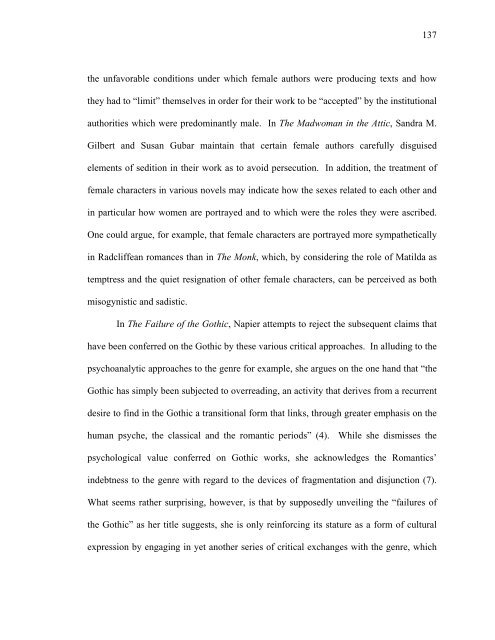Untitled - Sexey's School Moodle
Untitled - Sexey's School Moodle
Untitled - Sexey's School Moodle
You also want an ePaper? Increase the reach of your titles
YUMPU automatically turns print PDFs into web optimized ePapers that Google loves.
the unfavorable conditions under which female authors were producing texts and how<br />
they had to “limit” themselves in order for their work to be “accepted” by the institutional<br />
authorities which were predominantly male. In The Madwoman in the Attic, Sandra M.<br />
Gilbert and Susan Gubar maintain that certain female authors carefully disguised<br />
elements of sedition in their work as to avoid persecution. In addition, the treatment of<br />
female characters in various novels may indicate how the sexes related to each other and<br />
in particular how women are portrayed and to which were the roles they were ascribed.<br />
One could argue, for example, that female characters are portrayed more sympathetically<br />
in Radcliffean romances than in The Monk, which, by considering the role of Matilda as<br />
temptress and the quiet resignation of other female characters, can be perceived as both<br />
misogynistic and sadistic.<br />
137<br />
In The Failure of the Gothic, Napier attempts to reject the subsequent claims that<br />
have been conferred on the Gothic by these various critical approaches. In alluding to the<br />
psychoanalytic approaches to the genre for example, she argues on the one hand that “the<br />
Gothic has simply been subjected to overreading, an activity that derives from a recurrent<br />
desire to find in the Gothic a transitional form that links, through greater emphasis on the<br />
human psyche, the classical and the romantic periods” (4). While she dismisses the<br />
psychological value conferred on Gothic works, she acknowledges the Romantics’<br />
indebtness to the genre with regard to the devices of fragmentation and disjunction (7).<br />
What seems rather surprising, however, is that by supposedly unveiling the “failures of<br />
the Gothic” as her title suggests, she is only reinforcing its stature as a form of cultural<br />
expression by engaging in yet another series of critical exchanges with the genre, which



